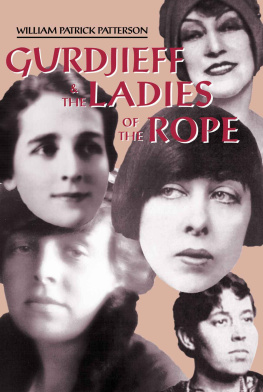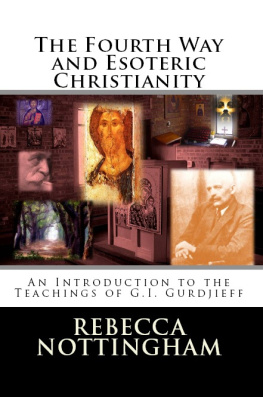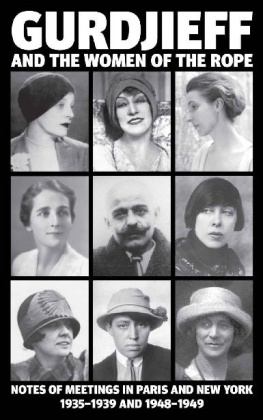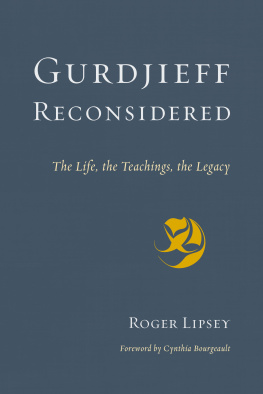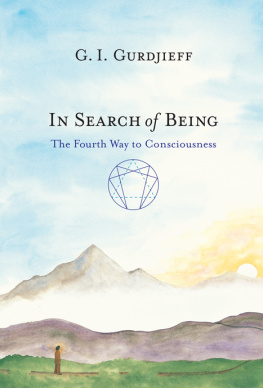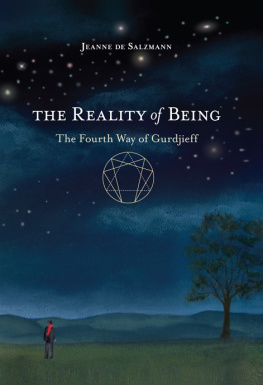Table of Contents
WILLIAM PATRICK PATTERSON
GURDJIEFF
& the LADIES
of the
ROPE

Barbara Allen Patterson, Editor
Arete Communications
Fairfax, California
Gurdjieff & the Ladies of the Rope
Copyright 1999 by William Patrick Patterson
Copyright 2013 by Arete Communications
All rights reserved. No part of this publication may be reproduced or transmitted in any form or by any means, electronic or mechanical, including photocopying, recording, or by any information storage and retrieval system, without permission in writing from Arete Communications. Reviewers may quote brief paragraphs.
Library of Congress Cataloging in Publication
Data Catalog Number: 98-70220
Patterson, William Patrick
Gurdjieff & the Ladies of the Rope
Bibliography: Includes notes, references, and index
1. G. I. Gurdjieff
2. Fourth Way
3. Jane Heap
4. Solita Solano
5. Kathryn Hulme
6. Margaret Anderson
First printing 1999
Second Printing 2004
First publication of this edition 2013
ISBN: 978-1-879514-41-6
Arete Communications
773 Center Boulevard #58
Fairfax, California 94978-0058
www.Gurdjieff-Legacy.Org
For
Vitvitskaa
Acknowledgments
This book has taken a tremendous amount of energy and time and could not have been published without the help and support of a great many friends. I would like to thank Henry Korman for the cover and book design and preparation of the final text; his wife Mary Ellen for inputting the text and inserting accurately and without complaint what I am sure seemed likeand wasa monumental number of changes; and to Teresa Adams for the creation of the index and her steadfast help in researching the archives. Henry, Mary Ellen and Teresa also made many useful comments and additions to the many drafts of the manuscript. I thank also Leanne Francis, Kathy Keers, and Mike Miller for proofreading the text; and, as always, my gratitude to my wife Barbara for bringing her professional editing skills, sensibility, and long standing support to this project. A special thanks, as well, to the many people who helped my research at the Beinecke Library, Yale University, Golda Meir Library at the University of Minnesota, the Special Collections Department at the University of Delaware, and the Library of Congress. Lastly, I would like to express my gratitude to Solita Solano for her notes of the Ropes many luncheons with Mr. Gurdjieff and generously giving the copyright to the Library of Congress.
Other books by the author
Adi Da Samraj-Realized or/and Deluded?
Spiritual Survival in a Radically Changing World-Time
The Life & Teachings of Carlos Castaneda
Eating The I
Taking with the Left Hand
Struggle of the Magicians
Voices in the Dark
Gurdjieff & the Ladies of the Rope
Video Trilogy
The Life & Significance of G. I. Gurdjieff
Gurdjieff in Egypt Part I 1890-1912
Gurdjieffs Mission Part II 1912-1924
Gurdjieffs Legacy Part III 1924-1949
Video
Introduction To Gurdjieffs Fourth Way:
From Selves To Individual Self To The Self
Prologue
On October 21, 1935, George Ivanovitch Gurdjieff formed a special women-only group of spiritual seekers. It began with four women and eventually grew to seven, all lesbians but one. Of Mr. Gurdjieffs many and varied activities during his work to establish the ancient teaching of the Fourth Way, his creation of this group is the least understood.
First appearing in Russia in 1912, it was Gurdjieffs mission to introduce the Fourth Way, reformulated for our time, to the West. Gurdjieff came because he believed that unless the wisdom of the East and the energy of the West are harnessed and used harmoniously the world will destroy itself.
In Russia he intended to establish the Institute for the Harmonious Development of Man for the practice and dissemination of the teaching. However, the sudden rise of the black tide of Bolshevism in 1917 made this impossible. After a number of attempts to establish it elsewhere, Gurdjieff opened the Institute in France in November 1922 at a chteau called the Prieur des Basses-Loges at Fontainebleau-en-Avon, some forty miles southeast of Paris.
Though his early lectures were heard by Western audiences only in translation, Gurdjieff immediately attracted people of a very high level, many highly intelligent, creative and successful in ordinary life. Foremost among them was Alfred Richard Orage, founder and editor of the New Age, a prominent London literary and political review, who gave up his editorship to follow Gurdjieff. What attracted Orage and people like him was not only the exceptional depth of Gurdjieffs understanding and knowledge, his Being, but the originality, scale and practicality of teaching itself. Nothing like it had ever been seen in the West. In fact, as Gurdjieff said The teaching whose theory is here being set out is completely self-supporting and independent of other lines and it has been completely unknown up to the present time.
In the 1920s, a number of more traditional teachings were making their appearance in the West as well. Hindu gurus, such as Vivekananda and Paramahansa Yogananda, Sufis, such as Hazrat Inayat Khan, and Buddhist monks had all come to the West. And, of course, there were the occult teachings of Madame Blavatskys Himalayan masters. But the Fourth Way had no antecedent.
In Left Bank expatriate circles the teachingand Gurdjieffgenerated a great deal of talk, even scandalous rumor. But for those having a serious interest no authoritative, substantial source of information was available. The teaching had no books. There were no lectures, no seminars. It had no center and no teacher for, following his serious car crash in July 1924, Gurdjieff had dissolved the Institute and no longer taught.
Since I had not, Gurdjieff explained, when in full strength and health, succeeded in introducing in practice into the life of people the beneficial truths elucidated for them by me, then I must at least, at any cost, succeed in doing this in theory, before my death. And so he had decided to give all his time to writing what he termed a Legominism, that is, a means by which initiates could transmit esoteric knowledge to future generations. Although he finished the final draft of the manuscript of All and Everything, First Series , before 1930, he would not authorize its publication until 1950.
For the first half of the twentieth century, then, all that was commonly known about the Fourth Way was that it was not a religion per se. There was no dogma, no belief system. Like traditional teachings, the Fourth Way was rooted in Tradition, yet, uniquely, it both appeared and disappeared. By thus avoiding a stultifying monolithic structure, it was free to take on a form correspondent with the time. Whatever form it might take, its principles remained unchanged. Rather than withdraw into a monastery or an ashram, the student of the Fourth Way stayed in life, learned to use lifeuse the uncertainty, shocks, suffering and negativity it producedto come to real life. One learned, for example, to extend intentionally the inner process of the conscious absorption of impressions, putting energy and faith only in consciousness and direct experience. Every idea and practice was to be verified by ones own intentional observation and experimentation. What was necessary was not devotion but effort; not belief, but self-study, self-sacrifice and understanding. And the effort had to be voluntary. It was not an effort made by the willful ego, but an effort of a special quality, one both psychological and organic, the aim being to impartially observe ones manifestations. In turn, this observation of self as it is not as imagined brings a genuine suffering, also of a different quality (one unlike the personal psychological, emotional or physical suffering usually attributed to the word). It is a suffering that only the seeing of the stark impersonal truth can evoke. It is only this intentional self-remembering and self-observation, repeated again and again, which can build sufficient pressure to crack the imprisoning shell of false personality so that essence can develop and higher-being bodies be formed, and a soul created.

